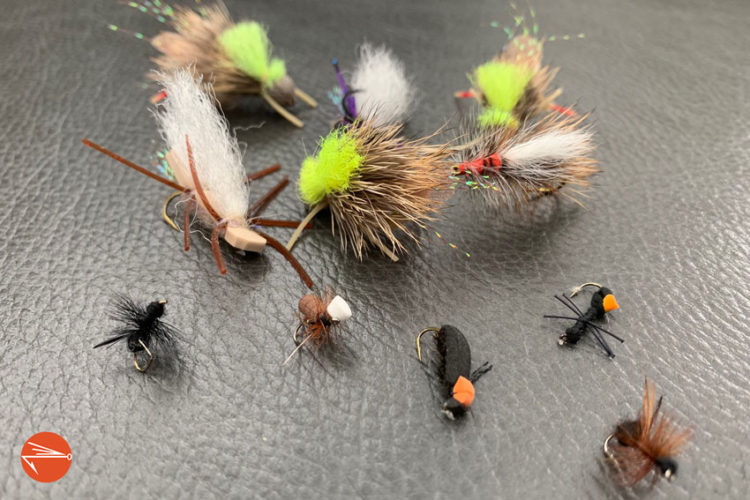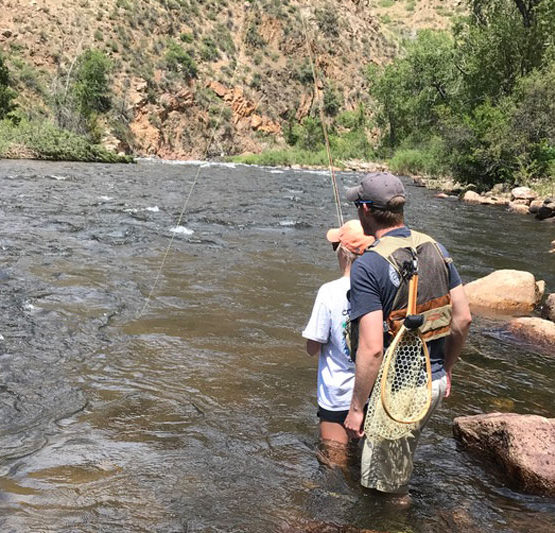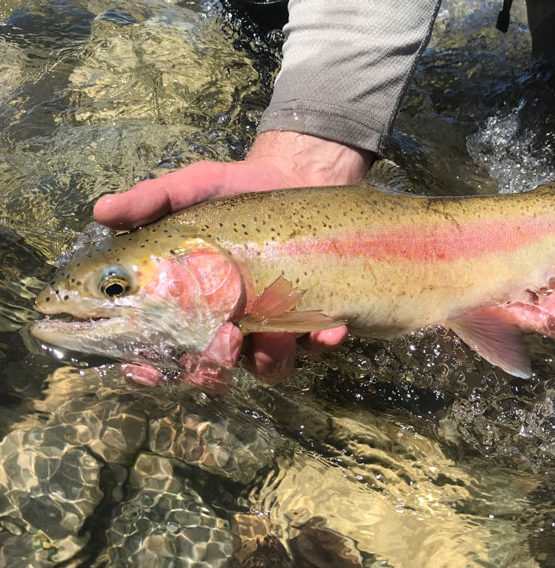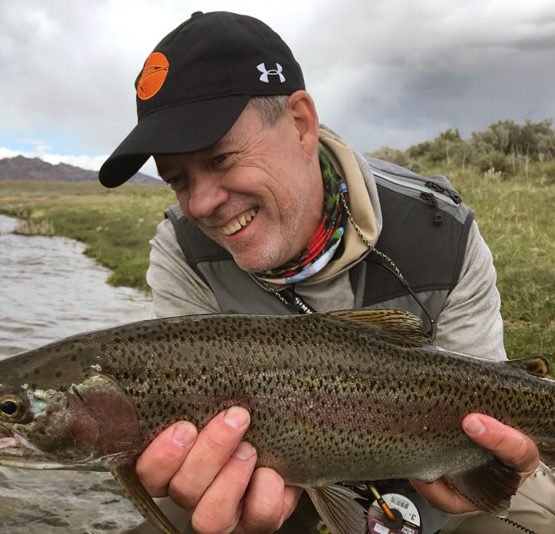Wondering what time of year is best for fly fishing with terrestrials? This post will teach you just about everything you need to know.
Whether expert or novice, most every fly fisher would likely agree that catching fish with terrestrial fly patterns is the most fun you can have with a fly rod in hand. Fished as dry flies, terrestrials imitate land-born bugs — grasshoppers, ants, spiders and the like — that have mistakenly landed in a rather dangerous situation: thrashing about in a body of water with a slew of predatory fish ravenously swirling below. When fished in-season, and when well matched to the insect life near said body of water, terrestrial imitations often draw electric strikes. With that thrilling image in mind, the overarching question becomes: What is the best time of year to fish terrestrials?
In general, the best time of year to fish terrestrials is between mid-June and late September. Of course, this time segment varies depending upon distance from the equator, local seasonal characteristics and other insect breeding and hatch considerations.
So, when prepping for a fly fishing outing during this timeframe, stock and be prepared to cast terrestrials for explosive fly fishing fun!
Just a note to let you southern hemisphere-ers know that we here at Fly Fishing Fix are not northern hemisphere superior-ists. The season noted above comes from our expertise as U.S. Colorado natives, where we fish most of the time. Of course, in the southern hemisphere, the seasons are basically mirror opposites, as are the associated bug breeding and hatching variables.
With that in mind, we always recommend checking with your local experts, no matter where on the globe you’re planning to fish. And that’s all I’m going to say about that.
So, now that you know what they are and when in the world to fish them, let’s talk about our all-time favorite go-to, never fail, slump-busting terrestrial fly fishing techniques.
Disclaimer: This post may contain affiliate links, meaning we will receive a small commission (at no cost to you) if you click through and make a purchase.Bigger Terrestrials Aren’t Always Better
For some reason, as fun as they are to fish, I hardly ever start my day on the water featuring terrestrials. Perhaps that has something to do with the fact that it’s usually early in the day; that, in the often chilly mountain air, cold-blooded terrestrial critters have yet to become active; or it may be that I simply have a bias toward presenting more delicate rigs as a kind of figurative genuflection to the serenity of the morning.
Whatever the reason, the later, warmer and windier it gets in the day, the more likely my reverential morning bias will take a back seat to my inner neanderthal.
And that’s when I find myself thinking big.
At this juncture, I reason that a big, juicy hopper pattern will naturally draw a big, juicy strike from a big, juicy rainbow when, were I to pay closer attention to the surrounding conditions and evident land-based fish food, I would discover nothing of the sort hopping or crawling about. In other words, I’ve gone big when it would have been much better to have gone small.
I said I was experienced. I didn’t say I was smart! Truth is, bigger is not always better. I’ve enjoyed some of my most productive terrestrial fly fishing sessions fishing smaller patterns.
Maybe it’s earlier in the season when the terrestrial life has not yet reached full adult size. Perhaps you’re fishing a high mountain lake where the land-based insect life never gets that big. Regardless, our advice: observe and match, to the best of your ability and fly supply, bug type, size and general bug color.
In such conditions, avoid the temptation to throw something giant. Doing so might just scare those underwater predators into their own aquatic version of a duck-and-cover drill.
You Might Also Like:
- What Are Parachute Flies? (Plus 5 Great Examples)
- 15 Best Flies For Cheesman Canyon
- 7 Best Strike Indicators For Fly Fishing
- 25 Proven Tips To Catch More Trout
- 25 Best Fly Fishing Gifts: A Legit Gift Guide For Anglers
Bigger Terrestrials Can Be Better
So, now that I’ve spilled all of that ink talking about why bigger isn’t always better, let me just add that bigger IS often better.
On many occasions — and usually as a frustrated reaction to a slow afternoon — I’ve thrown on a “big nasty” terrestrial pattern only to be rewarded with a sudden and startle-ya-back-to-life attack from an eager trout rising hard from the depths below.
And while a gaudy terrestrial presentation, with the wind, into a cut bank, will almost always do the trick, don’t assume a mid-river marauder or deep lake dweller won’t move just as hard for a hefty, leggy, gnarly terrestrial they see floundering on the surface out in the middle. They often will… and after all, whatcha got to lose?
Slap The Water
As noted above, whether they’ll come right out and admit it or not, terrestrial insects, for rather understandable reasons, are water wussies. Oh sure, you got your brave water spiders and such, but most dirt crawlers are about as interested in landing in a body of water as I am in smashing myself in the forehead with the business end of a ball-peen hammer.
I kid you not, I’ve often had the thought that their tiny insect brains must be nearly fully and always occupied with this single notion: water bad!
Therefore, if said terrestrial has violated this singular innate directive, it’s a good bet he or she has done so accidentally:
- A poorly-timed hop right as a strong gust of wind came along
- Knocked off an overhanging willow by a passing deer
- Trying to prove to a group of six-legged friends that the river leap would be no sweat.
Regardless, when a terrestrial hits the water, it’s usually with a splash. So, when casting a terrestrial, there’s no need to be dainty about it. That said, I don’t necessarily ascribe to the idea that you need to add any extra force. Depending upon the size of the bug you’re using, the weight of the imitation will often provide enough of its own splash without any extra casting thrust from the angler.
Since wind is often the catalyst for a terrestrial’s water landing, I do like to bring my cast in on an angle. Be willing to try different methods, including jiggling a mildly snagged cross-bank fly so that it tumbles in tight to the edge. If you can make it happen without worsening the snag, an off-the-bank terrestrial plopping into a dark cut-bank can be a great way to lure a lunker out from its shady lair.
Make It Twitch
Building on the theme above, a water-bound terrestrial goes into an immediate panic response (not unlike me when I’ve inadvertently insulted my wife). So, to mimic that behavior, once you’ve made your determined cast, don’t let your tasty terrestrial just sit there, lifeless, on the water. Try giving it a gentle and irregular twitch by taking in the slack line then subtly wiggling your rod tip.
Also, if you watch a natural terrestrial on the water, you’ll see that they thrash about a bit, then, tired, rest awhile before starting their struggle again. Try to copy this behavior with your imitation terrestrial and watch as a big brown attacks it like a cobra. Then hang on for a great ride!
Add A Dry Fly Or Dropper
One of our favorite terrestrial techniques is to add a trailing dry fly or a “dropper” nymph. In both cases, the lead terrestrial acts as an enticing meal, an attractor, and as an easy-to-see strike indicator.
Whenever I decide to add a second dry fly, I do so with a three to four foot section of monofilament nylon tippet which is attached to the hook bend of the lead bug. When trailing a dropper nymph, I typically keep my tippet section a little shorter and opt for fluorocarbon for enhanced sink and line invisibility. In either case, choose and treat the second fly as you would if it were your lead fly.
In other words, match the hatch with the adult dry fly or your nymph selection. Be sure to dry-dress the trailing dry fly as you would normally. Conversely, let your dropper nymph sink and drift on its own accord while focusing primarily on your lead terrestrial’s drift.
For added success, when trailing a nymph that you want to have sink deeper, rely on the nymph’s bead head to provide the weight. Adding any more weight than that can sink your lead terrestrial. And let’s face it, nobody likes a sunken terrestrial.
On the other hand, when trailing a tiny nymph it is best allowed to sink, of its own weight, just under the surface. It can also serve as a rather productive emerging temptation simply riding amid the surface foam.
Keep Your Terrestrial Dry (And Floating)
I think it’s well established that fly fishers can be a quirky lot. I’m certainly no exception. So, it shouldn’t come as any surprise that, in my observations of insect life, one of the things I’ve always marveled at is their amazing buoyancy. Maybe a weird thing to notice, yes, but weird people notice weird things… duh!
What’s the takeaway? If your presentations don’t look as natural as possible, you probably aren’t going to draw as many strikes as you would if you paid closer attention to pre-cast terrestrial preparation. This means, if your terrestrial fly isn’t dry and properly dressed with floatant, it won’t ride the surface as it should and, thus, won’t fool a wiley hog very often.
To increase your success, be sure to dry your fly out after every take or, periodically, when you see it beginning to sag in the water. Use a good fly-drying powder or liquid, or an amadou patch (or both), and, once dry, re-dress your terrestrial with floatant. A couple of false casts to give it one more level of dryness and you’ll be good to let fly (pun intended) with your next live-fire cast.
Reeling It All In
Though I love just about every kind of fly fishing I’ve ever done, I think, when push comes to shove, my favorite situation would have to be standing knee-deep in a cool mountain river on a warm summer afternoon, casting and drifting a beefy, easy-to-see terrestrial pattern (with a nymph dropper) into a deep run or cut-bank. Of course, this exercise is vastly enhanced by a steady stream of feisty fish who just can’t say no to a passing bacon cheeseburger.
Oh, and if you’d like to see a comprehensive list of our all-time favorite foam-based terrestrial patterns, make room in your fly box (or buy a few new ones) and check out this post. And while you’re at it, why not cruise over to this article for more on how to tie a dry-dropper rig.
Tight lines!










